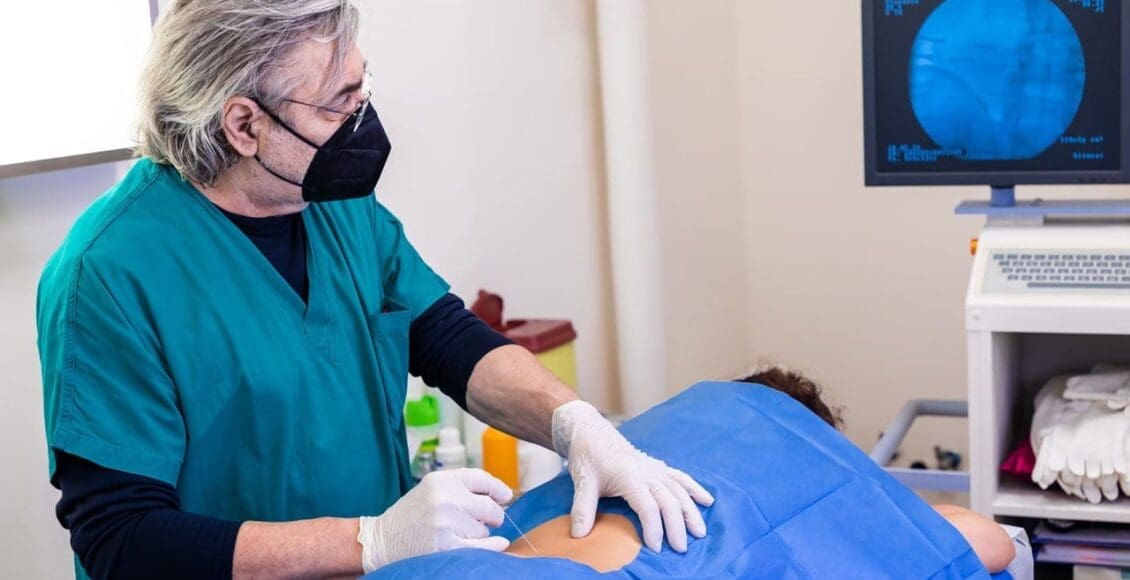Noninvasive treatments like chiropractic care, non-surgical decompression, massage therapy, non-steroidal anti-inflammatory drugs/NSAIDs, targeted/specific exercises, and ice/heat therapy successfully treat most cases of sciatica. However, more aggressive treatment could be necessary for severe cases, and this is where sciatica nerve block injections come in. The Injury Medical Chiropractic team can help you understand the diagnosis and explain the benefits.
Table of Contents
Sciatica Nerve Block
Sciatic nerve block treatments can provide profound relief for intense, non-stop symptoms. The procedure can also provide important diagnostic information to help the spine specialist locate the exact nerve fibers contributing to the symptoms.
- The nerve block stops sciatic pain signals from transmitting.
- The procedure involves injecting an anesthetic and a steroid into the nerve roots.
- The steroid reduces inflammation.
- The anesthetic prevents nerve impulses from reaching the central nervous system – CNS.
- If the procedure is successful, surgery could be avoided altogether.
What to Expect
Individuals undergoing a sciatic nerve block will be awake during the procedure. Individuals that rather be sedated are recommended to speak with their healthcare provider during the planning phase.
- When the procedure begins, a nurse sterilizes the area around the injection site and applies a local anesthetic.
- The nurse will check the injection area for numbness.
- Then the spine physician inserts a needle using direct visualization from an ultrasound, fluoroscope, or CT scan and then injects the medications.
- After the procedure, the individual is moved to a recovery area and monitored.
- Most individuals can walk almost immediately after the injection, and vigorous exercise can be resumed a few days following the procedure, depending on the injury and what the spine specialist recommends.
Possible Complications
The procedure is done under direct visualization to minimize the risk of complications. However, possible complications could present and are usually linked to the needle insertion into the spinal column. These include:
- Bleeding
- Nerve Injury
- Infection
Complications are rare, but side effects like soreness around the injection site, nausea, and a headache are common and only last a little while.
Candidates
Individuals with underlying conditions and that are taking various medications may not qualify for a sciatic nerve block or have to consult their doctor for reasons that include the following:
Long-Term Anticoagulant Use
- Individuals taking blood thinners like daily aspirin, Plavix, or coumadin, will need to stop taking these medications before the procedure.
Allergy to Contrast Dye
- Sciatic nerve blocks are done using contrast dye or ultrasound.
- Individuals with an allergy to contrast dye will need to verify with their doctor or surgeon the feasibility of only using ultrasound guidance.
Abnormal Spinal Anatomy
- Individuals with abnormal spine anatomy have an increased risk for complications and are recommended not to have the procedure.
Morbid Obesity
- Morbid obesity is a significant risk factor for developing sciatica.
- The pain and symptoms often improve with weight loss.
Infection
- Inserting a needle with an injury, wound, or active infection near or around the injection site could cause spreading.
Treatment Duration
There is a wide range of responses to sciatic nerve blocks.
- Most individuals experience pain and symptom relief between two weeks and two to four months.
- Some individuals have a long-term resolution of their symptoms.
- However, it is also possible for the nerve block to be unsuccessful.
Unsuccessful Outcomes
The sciatic nerve is the longest in the body, and there are multiple potential sites for an anesthetic blockade.
- If a sciatic nerve block does not work, the spine specialist will reanalyze the diagnosis and see if the injection site was correct.
- Identifying the exact section of the nerve to anesthetize can be difficult and may require multiple nerve block attempts.
Individuals who continue to experience debilitating sciatica symptoms after a sciatic nerve block could be recommended to undergo surgical procedures.
- Sciatic nerve ablation is a procedure that destroys nerve pathways identified to cause pain and can provide long-term relief.
- If sciatica is caused by misalignment of the vertebrae or intense external pressure on the sciatic nerve, surgery to correct the underlying cause could offer a permanent solution.
Sciatica Syndrome
References
5 Questions to Answer Before Considering Sciatica Surgery, Johns Hopkins Medicine, accessed September 28, 2022, https://www.hopkinsmedicine.org/health/conditions-and-diseases/back-pain/5-questions-to-answer-before-considering-sciatica-surgery.
Jönsson, B et al. “Diagnostic lumbar nerve root block.” Journal of spinal disorders vol. 1,3 (1988): 232-5.
Kanaan, Tareq, et al. “The Efficacy of Therapeutic Selective Nerve Block in Treating Lumbar Radiculopathy and Avoiding Surgery.” Journal of pain research vol. 13 2971-2978. 18 Nov. 2020, doi:10.2147/JPR.S276331
Rodziewicz TL, Stevens JB, Ajib FA, et al. Sciatic Nerve Block. [Updated 2022 June 11]. In: StatPearls [Internet]. Treasure Island (FL): StatPearls Publishing; 2022 Jan-. Available from: https://www.ncbi.nlm.nih.gov/books/NBK470391/
Sciatica: Harvard Health Publishing, (2016, February 19), accessed September 28, 2022, of all the nerve https://www.health.harvard.edu/pain/sciatica-of-all-the-nerve.
Senthelal S, Dydyk AM, Mesfin FB. Ablative Nerve Block. [Updated 2022 April 14]. In: StatPearls [Internet]. Treasure Island (FL): StatPearls Publishing; 2022 Jan-. Available from: https://www.ncbi.nlm.nih.gov/books/NBK499975/
Post Disclaimer
Professional Scope of Practice *
The information on this blog site is not intended to replace a one-on-one relationship with a qualified healthcare professional or licensed physician and is not medical advice. We encourage you to make healthcare decisions based on your research and partnership with a qualified healthcare professional.
Blog Information & Scope Discussions
Welcome to El Paso's Premier Wellness and Injury Care Clinic & Wellness Blog, where Dr. Alex Jimenez, DC, FNP-C, a board-certified Family Practice Nurse Practitioner (FNP-BC) and Chiropractor (DC), presents insights on how our team is dedicated to holistic healing and personalized care. Our practice aligns with evidence-based treatment protocols inspired by integrative medicine principles, similar to those found on this site and our family practice-based chiromed.com site, focusing on restoring health naturally for patients of all ages.
Our areas of chiropractic practice include Wellness & Nutrition, Chronic Pain, Personal Injury, Auto Accident Care, Work Injuries, Back Injury, Low Back Pain, Neck Pain, Migraine Headaches, Sports Injuries, Severe Sciatica, Scoliosis, Complex Herniated Discs, Fibromyalgia, Chronic Pain, Complex Injuries, Stress Management, Functional Medicine Treatments, and in-scope care protocols.
Our information scope is limited to chiropractic, musculoskeletal, physical medicine, wellness, contributing etiological viscerosomatic disturbances within clinical presentations, associated somato-visceral reflex clinical dynamics, subluxation complexes, sensitive health issues, and functional medicine articles, topics, and discussions.
We provide and present clinical collaboration with specialists from various disciplines. Each specialist is governed by their professional scope of practice and their jurisdiction of licensure. We use functional health & wellness protocols to treat and support care for the injuries or disorders of the musculoskeletal system.
Our videos, posts, topics, subjects, and insights cover clinical matters and issues that relate to and directly or indirectly support our clinical scope of practice.*
Our office has made a reasonable effort to provide supportive citations and has identified relevant research studies that support our posts. We provide copies of supporting research studies available to regulatory boards and the public upon request.
We understand that we cover matters that require an additional explanation of how they may assist in a particular care plan or treatment protocol; therefore, to discuss the subject matter above further, please feel free to ask Dr. Alex Jimenez, DC, APRN, FNP-BC, or contact us at 915-850-0900.
We are here to help you and your family.
Blessings
Dr. Alex Jimenez DC, MSACP, APRN, FNP-BC*, CCST, IFMCP, CFMP, ATN
email: coach@elpasofunctionalmedicine.com
Licensed as a Doctor of Chiropractic (DC) in Texas & New Mexico*
Texas DC License # TX5807
New Mexico DC License # NM-DC2182
Licensed as a Registered Nurse (RN*) in Texas & Multistate
Texas RN License # 1191402
ANCC FNP-BC: Board Certified Nurse Practitioner*
Compact Status: Multi-State License: Authorized to Practice in 40 States*
Graduate with Honors: ICHS: MSN-FNP (Family Nurse Practitioner Program)
Degree Granted. Master's in Family Practice MSN Diploma (Cum Laude)
Dr. Alex Jimenez, DC, APRN, FNP-BC*, CFMP, IFMCP, ATN, CCST
My Digital Business Card


